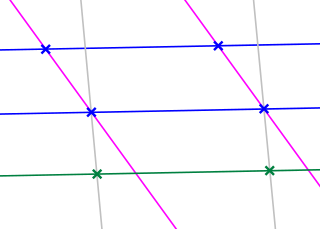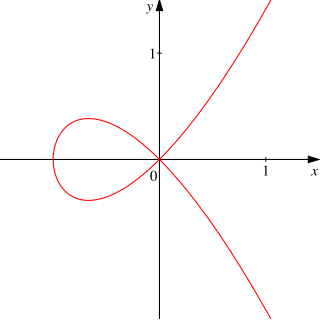
Euclidean space is the fundamental space of geometry, intended to represent physical space. Originally, in Euclid's Elements, it was the three-dimensional space of Euclidean geometry, but in modern mathematics there are Euclidean spaces of any positive integer dimension n, which are called Euclidean n-spaces when one wants to specify their dimension. For n equal to one or two, they are commonly called respectively Euclidean lines and Euclidean planes. The qualifier "Euclidean" is used to distinguish Euclidean spaces from other spaces that were later considered in physics and modern mathematics.

In Euclidean geometry, an affine transformation or affinity is a geometric transformation that preserves lines and parallelism, but not necessarily Euclidean distances and angles.

In mathematics, affine geometry is what remains of Euclidean geometry when ignoring the metric notions of distance and angle.

Algebraic varieties are the central objects of study in algebraic geometry, a sub-field of mathematics. Classically, an algebraic variety is defined as the set of solutions of a system of polynomial equations over the real or complex numbers. Modern definitions generalize this concept in several different ways, while attempting to preserve the geometric intuition behind the original definition.

In mathematics, an affine space is a geometric structure that generalizes some of the properties of Euclidean spaces in such a way that these are independent of the concepts of distance and measure of angles, keeping only the properties related to parallelism and ratio of lengths for parallel line segments. Affine space is the setting for affine geometry.

In algebraic geometry, an affine algebraic set is the set of the common zeros over an algebraically closed field k of some family of polynomials in the polynomial ring An affine variety or affine algebraic variety, is an affine algebraic set such that the ideal generated by the defining polynomials is prime.
In mathematics, a scheme is a mathematical structure that enlarges the notion of algebraic variety in several ways, such as taking account of multiplicities and allowing "varieties" defined over any commutative ring.

In differential geometry, an affine connection is a geometric object on a smooth manifold which connects nearby tangent spaces, so it permits tangent vector fields to be differentiated as if they were functions on the manifold with values in a fixed vector space. Connections are among the simplest methods of defining differentiation of the sections of vector bundles.

In geometry, Brianchon's theorem is a theorem stating that when a hexagon is circumscribed around a conic section, its principal diagonals meet in a single point. It is named after Charles Julien Brianchon (1783–1864).

Eulithidium is a genus of small colorful sea snails, marine gastropod mollusks in the family Phasianellidae, the pheasant shells.
Carenum is a genus of beetles in the family Carabidae, containing the following species:
Carenum anthracinum is a species of ground beetle in the subfamily Scaritinae, found in Australia. It was described by William John Macleay in 1864.
Carenum coruscum is a species of ground beetle in the subfamily Scaritinae, found in Australia. It was described by William John Macleay in 1864.
Carenum distinctum is a species of ground beetle in the subfamily Scaritinae, found in Australia. It was described by William John Macleay in 1864.
Carenum elegans is a species of ground beetle in the subfamily Scaritinae, tribe Scaritini and subtribe Carenina. It was described by William John Macleay in 1864 from Port Denison, Western Australia.
Carenum laevigatum is a species of ground beetle in the subfamily Scaritinae, found in Australia. It was described by William John Macleay in 1864.
Carenum puncticolle is a species of ground beetle in the subfamily Scaritinae, found in Australia. It was described by William John Macleay in 1864.
Carenum rectangulare is a species of ground beetle in the subfamily Scaritinae, found in Australia. It was described by William John Macleay in 1864.
Carenum violaceum is a species of ground beetle in the subfamily Scaritinae, found in Australia. It was described by William John Macleay in 1864.

Desmophyllum is a genus of cnidarians belonging to the family Caryophylliidae.









